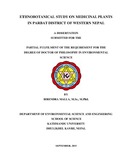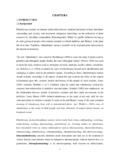Please use this identifier to cite or link to this item:
http://archive.nnl.gov.np:8080/handle/123456789/368| Title: | ETHNOBOTANICAL STUDY ON MEDICINAL PLANTS IN PARBAT DISTRICT OF WESTERN NEPAL |
| Authors: | MALLA, BIRENDRA |
| Keywords: | Ethnobotanical studies |
| Issue Date: | 28-Mar-2019 |
| Abstract: | Ethnobotany, the science that explains the relationship between people and their plant environment, documents indigenous knowledge of aborigines on the use of variety of plants and their parts. Systematic inquiries have been carried out to understand the existing and potential use of the plants in different areas. In view of rich floristic composition and diverse ethnic people‟s existence since long and yet minimum level of study in Parbat district, this research was carried out to a) assess floristic composition, spatial distribution of taxa, plant taxonomy, cross-cultural pattern of uses, and ethno-domestication; b) examine medicinal and other uses of the plant species, and mode of application; and c) analyze phytochemical properties and values, informants consensus factors (FIC), and fidelity level (FL) value of plant species. A number of field visits, in four different seasons, were carried out from August 2010 to December 2014 using in situ inventory method. Information was obtained from three indigenous groups – Gurung, Magar and Majhi – through semi-structured questionnaire, focus group discussions and personal interviews. The data were analyzed by standardized qualitative methods and quantitative spectrophotometric protocols. In this study, 401 plant species were identified which were categorized into 289 genera under 114 botanical families. Herbs represented the highest proportion of the plants followed by trees, shrubs and climbers respectively. Similarly, dicotyledons were the highest (86 families) and gymnosperms were the lowest (4 families). Likewise, Asteraceae (20 species) was found to be the most dominantly used family followed by Fabaceae (18 species) and Orchidaceae (17 species) respectively. This showed that Parbat is affluent with vast floristic diversity of ethnobotanical plants. Based on the species‟ use for different ailments, FIC values were calculated. The results showed that the diseases under cancer category had the highest agreement with FIC of 0.98. Species like Taxus wallichiana, Kalanchoe spathulata, Podophyllum hexandrum and Bergenia ciliata were used to cure the disease like cancer. Calculation of FL values showed Centella asiatica (100%), Crateva unilocularis (100%), Dactylorhiza hatagirea (100%) and Swertia chirayita (100%) are the most important species used for musculoskeletal and nervous system, cardiovascular disease, urinogenital and veneral ailments, cardiovascular diseases respectively. |
| Description: | DEPARTMENT OF ENVIRONMENTAL SCIENCE AND ENGINEERING SCHOOL OF SCIENCE KATHMANDU UNIVERSITY DHULIKHEL KAVRE, NEPAL |
| URI: | http://103.69.125.248:8080/xmlui/handle/123456789/368 |
| Appears in Collections: | 500 Natural sciences and mathematics |
Files in This Item:
| File | Description | Size | Format | |
|---|---|---|---|---|
| 1. Cover letter with Abstract.pdf | 236.79 kB | Adobe PDF |  View/Open | |
| 2. Chapter 1-5.pdf | 2.72 MB | Adobe PDF |  View/Open | |
| 3. Chapter 6-7.pdf | 1.19 MB | Adobe PDF |  View/Open | |
| 4. References.pdf | 475.44 kB | Adobe PDF |  View/Open |
Items in DSpace are protected by copyright, with all rights reserved, unless otherwise indicated.